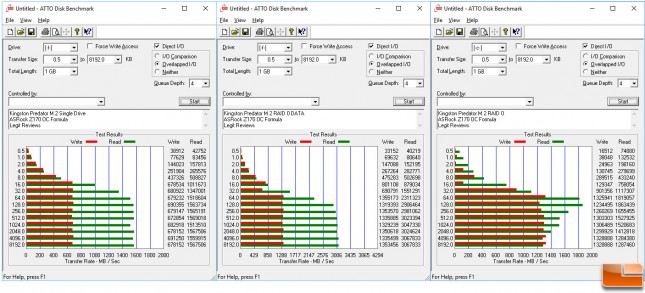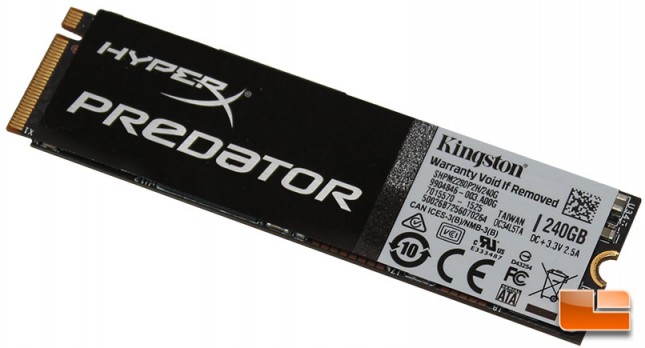HyperX Predator PCIe M.2 SSD Bootable RAID 0 Performance
HyperX Predator PCIe M.2 RAID 0 Performance
With Windows 10 Professional installed, and all updates installed we will test the performance of the HyperX Predator RAID 0 with CrystalDiskMark and ATTO. The HyperX Predator M.2 drives are rated for speeds up to 1400MB/s sequential read, and 600MB/s sequential write. To get a sense of how the RAID 0 works with the HyperX Predator M.2 240GB (Model SHPM2280P2H), we tested it as a single M.2 drive, RAID 0 as a DATA drive, and RAID 0 as a bootable OS drive. Each of the tests were run multiple times to validate the results, each time, the results were nearly identical, with a slight deviation between each run.
For CrystalDiskMark, as a single drive, the HyperX Predator recevied a 1376MB/s for sequential read, and 684.4MB/s for sequential write; the sequential read is slightly under the maximum that Kingston rates the drive for, while the write speed was slightly faster. Once we moved it into a RAID 0 configuration, the sequential read and write speed skyrocketed to almost double the single drive speed, which is what we would expect. As a bootable RAID 0 OS drive, the sequential read numbers were 1943MB/s and sequential write was 1331MB/s. There was a fairly significant drop in Sequential Read performance once data was put on the RAID 0 array and it was being used as the boot drive for our Windows 10 installation. That gives the sequential read speed close to a 41% boost in speed, while the sequential write speed received an incredible 94.5% boost! Either way, running the HyperX Predator M.2 drives in a RAID 0 will certainly give you a big boost in drive speed.
Checking out ATTO’s results, as a single drive, we see similar results to CrystalDiskMark. Moving to the RAID 0 DATA drive test, we see the results we expected for the Read testing, with the read speed leveling out around the 128KB mark, with around a 3000MB/s speed, while the write speed leveled out at the 64KB mark running in the 1300MB’s range for the remainder of the test. As a bootable OS drive, the read speed reached 1863MB/s at 128KB and gradually slowed down from there. The write speed was once again fairly steady after the 64KB test averaging around 1300MB/s as well. What was unexpected is that when the M.2 drives were configured for RAID 0 and used as the boot drive, the Read speed never leveled out as we typically see with SSD’s.
Final Thoughts and Conclusions
The Intel Z170 chipset introduced several new features that can allow users to get more out of their systems such as bootable RAID with high speed M.2 drives. By itself, the HyperX Predator is already a fairly fast drive if you compare it to standard SATA SSD’s. When it came out, almost a year ago, it was one of the fastest drives available. Putting two of them into a RAID configuration can allow you to push the speed even further and get more out of the drives with almost double the speed when used as a data drive, or about a 40% boot in speed as the bootable OS drive.
If you already have a Kingston HyperX Predator PCIe M.2 drive and have upgraded your system to the Intel Skylake processors with the Intel Z170 chipset, you can pick up a second one and run it in a RAID 0 configuration and boot from it, making a very fast boot drive. The HyperX Predator M.2 drive that we tested was the 240GB model, SHPM2280P2H, which can be found online for $194.99 with free shipping. With as quickly as technology is advancing, the HyperX Predator might not be the fastest M.2 drive available, however if you already have one, or just looking for a reliable M.2 drive the HyperX Predator M.2 is a great choice.
Legit Bottom Line: The Intel Z170 chipset has the capability of running M.2 drives in a bootable RAID configuration, making for an extremely fast boot drive. The firmware update by Kingston allows their HyperX Predator M.2 drives to be used on Z170 motherboards as a fast bootable RAID drive.



